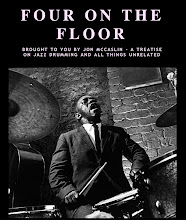In my previous post the patterns incorporated the snare drum, small tom, floor tom and ride cymbal (with the bass drum). Today I was messing around with this exercise and discovered even more practical variations if I actually LEFT OUT some drums.
Let me explain…
To review, here's my previous exercise (check out my other previous post for a more comprehensive explanation):
1) Play each line of Stick Control as eighth-notes with the hi-hat on beats 2&4 (or on all four quarter notes)
2) Divide each bar into TWO equal parts (ie. beats 1 & 2 and 3 & 4) and use the following orchestrations:
Beats 1+ 2+ : R = ride cymbal & bass drum, L = small tom
Beats 3+ 4+ : R = floor tom, L = snare drum
--------------------------------------------------------
Okay, so as you practice the first few pages of Stick Control you should come up with some fun things to play (and as I discovered, some very melodic ideas as well).
To come up with a wealth of other variations, leave one hand on one instrument, essentially leaving OUT one instrument. For example:
Beats 1+ 2+ : R = ride cymbal & bass drum, L = snare drum
Beats 3+ 4+ : R = floor tom, L = snare drum
* Or the reverse
Beats 1+ 2+ : R = floor tom, L = snare drum
Beats 3+ 4+ : R = ride cymbal & bass drum, L = snare drum
Try this one, which leaves the snare drum out all together:
Beats 1+ 2+ : R = ride cymbal & bass drum, L = small tom
Beats 3+ 4+ : R = floor tom, L = small tom
Try this one, which leaves the snare drum out all together:
Beats 1+ 2+ : R = ride cymbal & bass drum, L = small tom
Beats 3+ 4+ : R = floor tom, L = small tom
* Or the reverse
Beats 1+ 2+ : R = floor tom, L = small tom
Beats 3+ 4+ : R = ride cymbal & bass drum, L = small tom
If I wanted to get really "ride cymbal" centric I might try playing all the R's as ride cymbal + bass drum with the L's orchestrated between the other two or three drums accordingly.
Have fun with it and see how many other combinations you can come up with.
If I wanted to get really "ride cymbal" centric I might try playing all the R's as ride cymbal + bass drum with the L's orchestrated between the other two or three drums accordingly.
Have fun with it and see how many other combinations you can come up with.




















No comments:
Post a Comment